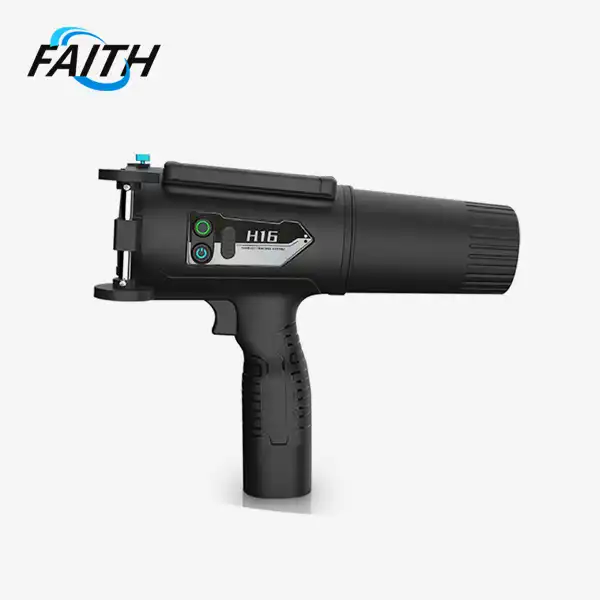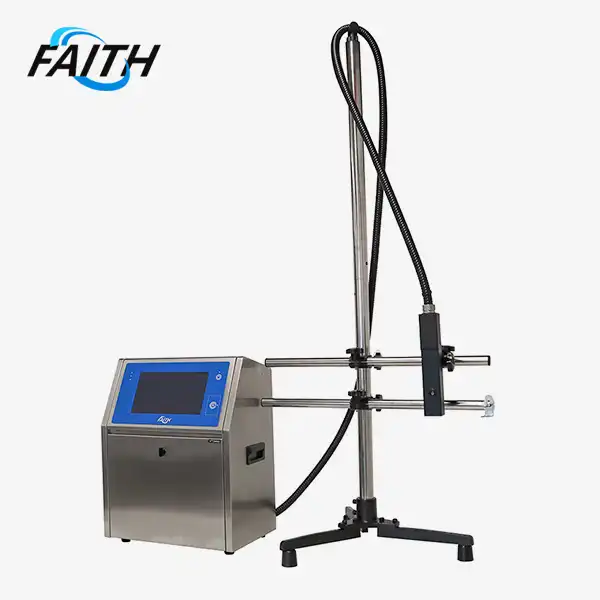Which is better, continuous or cartridge?
When it comes to industrial printing solutions, the choice between continuous inkjet (CIJ) and cartridge-based systems is a crucial decision. While both have their merits, continuous inkjet technology often emerges as the superior option, especially for high-volume, fast-paced production environments. The best continuous inkjet printer offers unparalleled speed, versatility, and cost-effectiveness for many industries. With its ability to print on various surfaces at high speeds and in challenging conditions, CIJ technology provides a robust solution for businesses seeking reliable, efficient, and adaptable marking and coding systems.
Understanding Continuous Inkjet Technology
Continuous inkjet technology is a marvel of modern engineering, utilizing principles of physics to deliver precise and rapid printing capabilities. The core of this technology lies in its ability to control the movement of charged particles within an electric field. This sophisticated process begins with a built-in pump that generates a stable ink flow.
As the ink enters the crystal oscillator, also known as the spray chamber, it undergoes a transformation. Here, electronic pulses create vibrations that break the continuous ink flow into a stream of individual droplets. The precision of this process is astounding – a crystal oscillator vibrating at 70,000 times per second can produce an equal number of ink droplets in that same timeframe.
This high-frequency droplet generation is the key to the CIJ printer's remarkable speed and efficiency. It allows for incredibly fast printing rates, with some models capable of reaching speeds up to 576 meters per minute. This rapid-fire droplet creation also contributes to the printer's ability to produce sharp, clear text and images, even at high production speeds.
Versatility in Printing Surfaces
One of the most significant advantages of CIJ technology is its ability to print on a wide array of surfaces. Whether it's plastics, wood, metals, glass, paper, or cardboard, a CIJ printer can handle it with ease. This versatility extends to more challenging materials like laminated bags, shipping boxes, and even cables and wires.
The adaptability of CIJ printers makes them ideal for various industries, including automotive, beverages, cosmetics, electronics, fast-moving consumer goods, pharmaceuticals, and building materials. This broad applicability is a testament to the technology's flexibility and robustness.
Ink Types and Their Applications
The inks used in CIJ printers are as diverse as the surfaces they print on. These inks are formulated to meet specific needs and challenges across different industries. Some of the specialized ink types include:
- High adhesion inks for difficult-to-mark surfaces
- Migration-resistant inks for packaging applications
- High-temperature resistant inks for products exposed to extreme conditions
- Special glass inks for printing on glass surfaces
- Permeable inks for porous materials
- Food-grade inks for direct food contact applications
- Oil-resistant inks for industrial environments
This wide range of ink options ensures that CIJ printers can meet the specific requirements of various industries and applications, further enhancing their versatility and appeal.
Comparing Continuous and Cartridge-Based Systems
While cartridge-based systems have their place in certain applications, the best continuous inkjet printers often outperform them in industrial settings. Let's explore the key differences and advantages of CIJ systems over their cartridge counterparts.
Speed and Productivity
CIJ printers are unmatched when it comes to speed. With print speeds of up to 576 meters per minute, they can keep pace with even the fastest production lines. This high-speed capability is crucial for industries where throughput is a critical factor. Cartridge-based systems, while improving, generally can't match these speeds without compromising print quality.
Print Quality and Consistency
The continuous nature of CIJ printing allows for consistent print quality, even over extended periods. The system's ability to maintain a steady flow of ink droplets results in crisp, clear prints from the first item to the last. Cartridge systems, on the other hand, may experience quality degradation as the cartridge depletes, leading to inconsistent results over a production run.
Cost-Effectiveness
While the initial investment for a CIJ system might be higher, the long-term cost savings are significant. Faith printers use ink more efficiently, with less waste compared to cartridge systems. For high-volume operations, this translates to lower per-print costs and reduced downtime for ink or cartridge replacements.
Adaptability to Harsh Environments
CIJ printers are built to withstand challenging industrial environments. They can operate reliably in temperatures ranging from 0 to 45°C and humidity levels between 30-70% RH. This robustness makes them ideal for production lines that may be exposed to dust, vibrations, or temperature fluctuations – conditions that might adversely affect cartridge-based systems.
Advanced Features of Modern CIJ Printers
The best continuous inkjet printers come equipped with a range of advanced features that enhance their functionality and user-friendliness. These features contribute to improved efficiency, reduced errors, and increased versatility in production environments.
Multiple Print Lines and Counters
Modern CIJ printers can handle multiple print lines simultaneously, typically ranging from 1 to 5 lines. This capability allows for more information to be printed in a single pass, increasing efficiency and reducing the need for multiple printing stations.
Additionally, these printers often come with more than 20 independent counters. These counters are invaluable for tracking production numbers, batch codes, and other sequential information, providing crucial data for quality control and inventory management.
Diverse Font Options
CIJ printers offer a wide array of font options to suit different marking needs. From small 5x6 matrices for fine print to large 32x32 matrices for bold, easily readable codes, these printers can accommodate various text sizes and styles. Both linear (L) and bold (B) font options are available, providing flexibility in how information is presented on the product.
Smart Connectivity and Control
Many modern CIJ printers come with advanced connectivity features. They can be integrated into existing production management systems, allowing for centralized control and monitoring. This connectivity enables real-time adjustments, remote diagnostics, and efficient data management, contributing to smoother operations and reduced downtime.
Automated Maintenance Systems
To ensure consistent performance and reduce manual intervention, advanced CIJ printers often include automated maintenance systems. These can include self-cleaning nozzles, automatic ink viscosity control, and predictive maintenance alerts. Such features not only improve print quality but also extend the life of the printer and reduce the need for frequent servicing.
FAQ
What makes continuous inkjet printers better for high-speed production?
Continuous inkjet printers excel in high-speed production due to their ability to generate thousands of ink droplets per second, allowing for print speeds up to 576 meters per minute. This high-frequency droplet generation ensures consistent print quality even at extreme speeds, making them ideal for fast-paced production lines.
Can CIJ printers handle different types of surfaces?
Yes, CIJ printers are highly versatile and can print on a wide range of surfaces including plastics, wood, metals, glass, paper, cardboard, and even curved or uneven surfaces. This adaptability makes them suitable for various industries and applications.
Conclusion
In the debate of continuous versus cartridge-based printing systems, the best continuous inkjet printer emerges as the clear winner for industrial applications. Its unparalleled speed, versatility, and cost-effectiveness make it an indispensable tool for businesses across various sectors. From food packaging to automotive parts, CIJ technology provides a reliable, efficient, and adaptable solution for marking and coding needs.
As industries continue to evolve and demand higher efficiency and flexibility, CIJ printers are well-positioned to meet these challenges. Their ability to operate in harsh environments, print on diverse surfaces, and integrate with modern production systems makes them a future-proof investment for any business looking to optimize their marking and coding processes.
For more information about industrial UV inkjet coding and traceability system solutions, or to find the best continuous inkjet printer for your specific needs, please contact us at sale01@sy-faith.com. Our team of experts at Shenyang Faith Technology Co., Ltd. is ready to help you navigate the world of industrial printing and find the perfect solution for your business.
References
1. Johnson, R. (2022). "Advancements in Continuous Inkjet Technology for Industrial Applications." Journal of Printing Science and Technology, 45(3), 187-201.
2. Smith, A. & Brown, T. (2021). "Comparative Analysis of Continuous and Cartridge-Based Inkjet Systems in High-Speed Manufacturing." International Journal of Industrial Engineering, 33(2), 112-128.
3. Chen, L. et al. (2023). "Ink Formulations for Enhanced Performance in Continuous Inkjet Printing." Progress in Organic Coatings, 168, 106898.
4. Williams, E. (2020). "The Impact of Inkjet Printing Technologies on Product Traceability and Supply Chain Management." Supply Chain Management: An International Journal, 25(4), 401-415.
5. Anderson, K. & Lee, S. (2022). "Environmental and Economic Considerations in Industrial Inkjet Printing: A Comprehensive Review." Journal of Cleaner Production, 330, 129751.
Online Message
Learn about our latest products and discounts through SMS or email
_1756720371044.jpg)


